coolant temperature Hyundai Equus 2016 Owner's Manual
[x] Cancel search | Manufacturer: HYUNDAI, Model Year: 2016, Model line: Equus, Model: Hyundai Equus 2016Pages: 477, PDF Size: 16.25 MB
Page 157 of 477
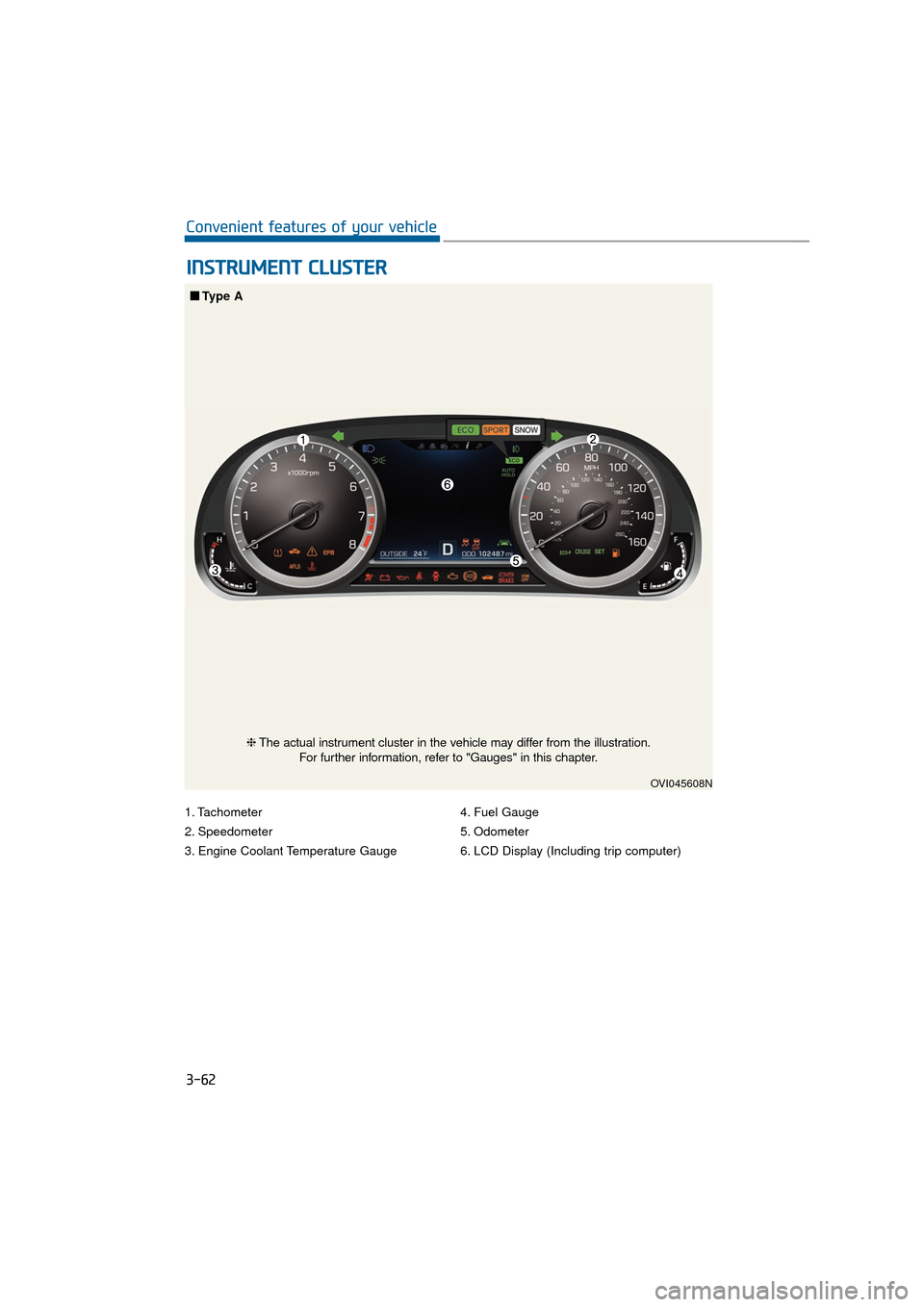
1. Tachometer
2. Speedometer
3. Engine Coolant Temperature Gauge4. Fuel Gauge
5. Odometer
6. LCD Display (Including trip computer)
I I
N
N S
ST
T R
R U
U M
M E
EN
N T
T
C
C L
LU
U S
ST
T E
ER
R
3-62
Convenient features of your vehicle
OVI045608N
■
■
Type A
❈The actual instrument cluster in the vehicle may differ from the illustration.
For further information, refer to "Gauges" in this chapter.
Page 158 of 477
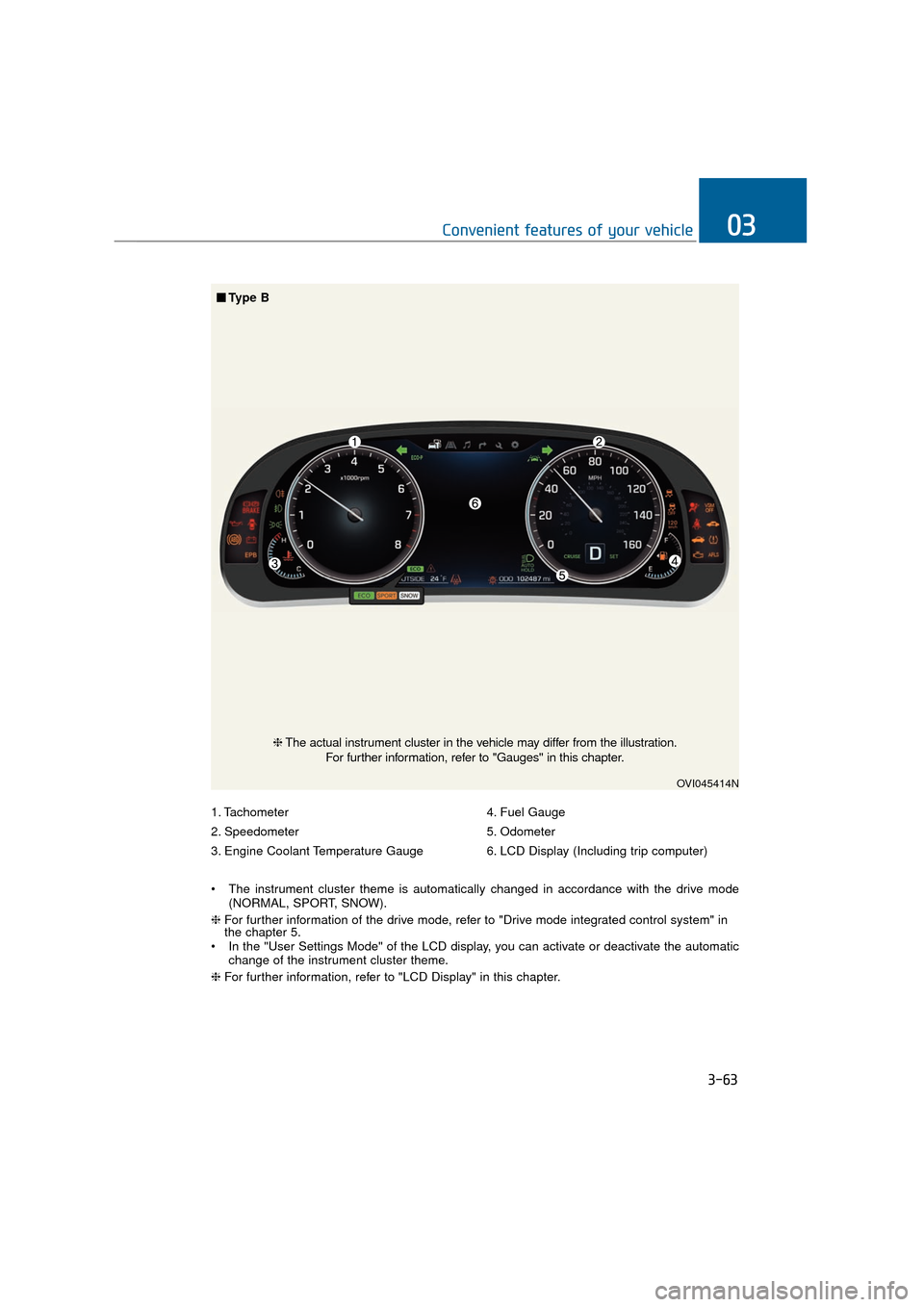
3-63
Convenient features of your vehicle03
1. Tachometer
2. Speedometer
3. Engine Coolant Temperature Gauge4. Fuel Gauge
5. Odometer
6. LCD Display (Including trip computer)
The instrument cluster theme is automatically changed in accordance with the drive mode (NORMAL, SPORT, SNOW).
❈ For further information of the drive mode, refer to "Drive mode integrated control system" in
the chapter 5.
In the "User Settings Mode" of the LCD display, you can activate or deactivate the automatic change of the instrument cluster theme.
❈ For further information, refer to "LCD Display" in this chapter.
OVI045414N
❈The actual instrument cluster in the vehicle may differ from the illustration.
For further information, refer to "Gauges" in this chapter.
■ ■
Type B
Page 161 of 477
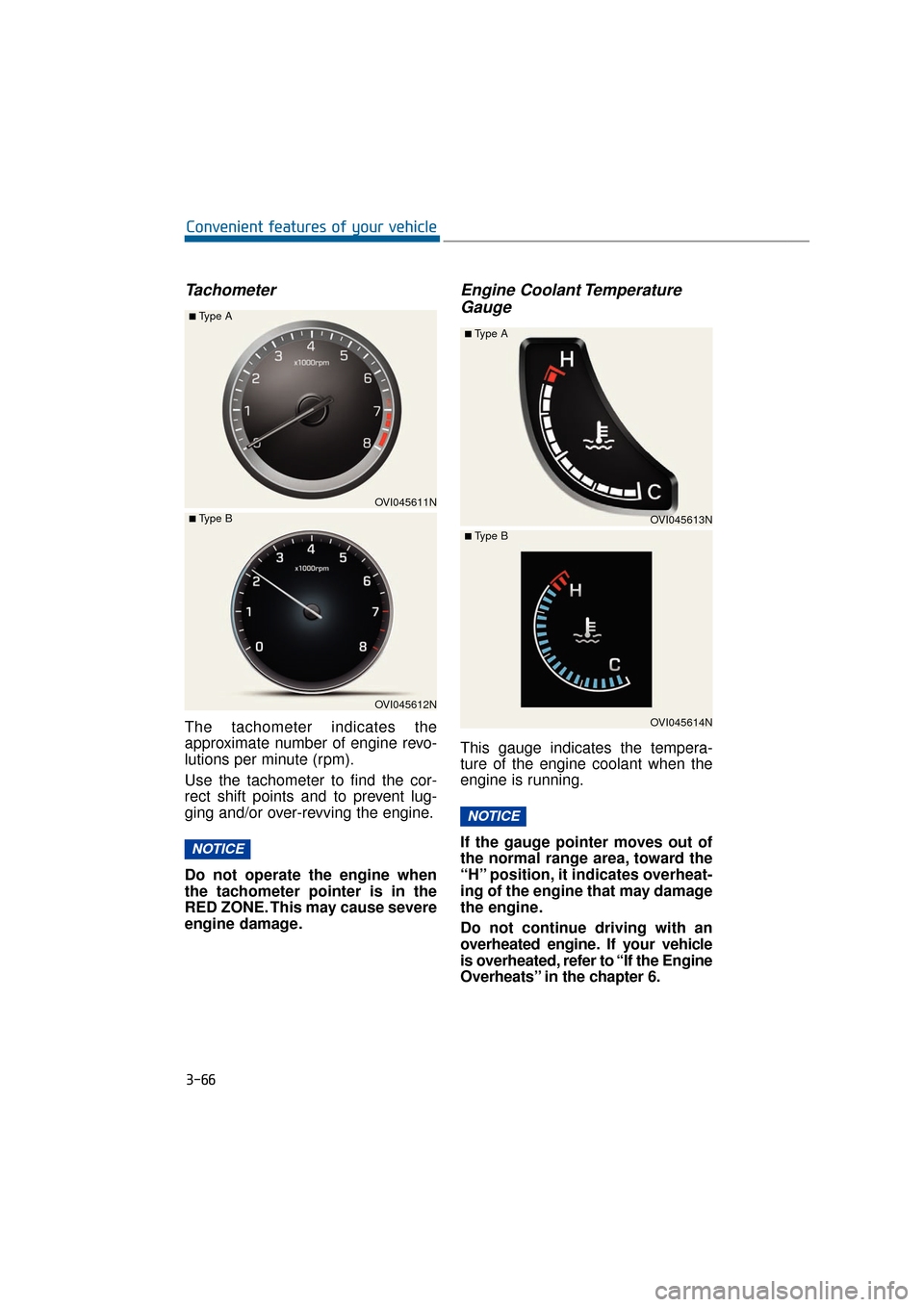
Tachometer
The tachometer indicates the
approximate number of engine revo-
lutions per minute (rpm).
Use the tachometer to find the cor-
rect shift points and to prevent lug-
ging and/or over-revving the engine.
Do not operate the engine when
the tachometer pointer is in the
RED ZONE. This may cause severe
engine damage.
Engine Coolant TemperatureGauge
This gauge indicates the tempera-
ture of the engine coolant when the
engine is running.
If the gauge pointer moves out of
the normal range area, toward the
“H” position, it indicates overheat-
ing of the engine that may damage
the engine.
Do not continue driving with an
overheated engine. If your vehicle
is overheated, refer to “If the Engine
Overheats” in the chapter 6.
NOTICE
NOTICE
3-66
Convenient features of your vehicle
OVI045611N
■Type A
OVI045612N
■ Type BOVI045613N
■Type A
OVI045614N
■ Type B
Page 187 of 477
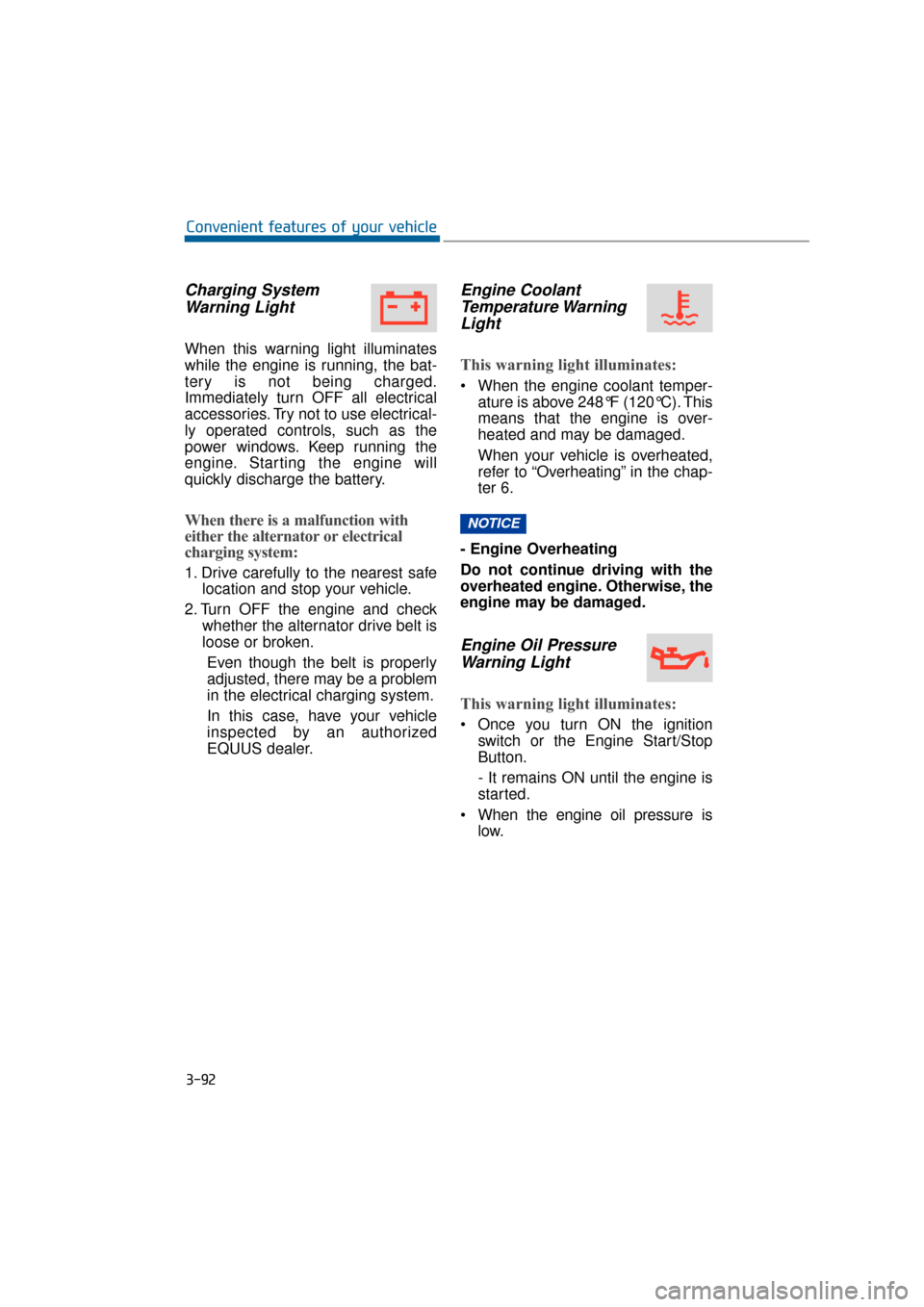
Charging SystemWarning Light
When this warning light illuminates
while the engine is running, the bat-
tery is not being charged.
Immediately turn OFF all electrical
accessories. Try not to use electrical-
ly operated controls, such as the
power windows. Keep running the
engine. Starting the engine will
quickly discharge the battery.
When there is a malfunction with
either the alternator or electrical
charging system:
1. Drive carefully to the nearest safe location and stop your vehicle.
2. Turn OFF the engine and check whether the alternator drive belt is
loose or broken.
Even though the belt is properly
adjusted, there may be a problem
in the electrical charging system.
In this case, have your vehicle
inspected by an authorized
EQUUS dealer.
Engine CoolantTemperature WarningLight
This warning light illuminates:
When the engine coolant temper-
ature is above 248°F (120°C). This
means that the engine is over-
heated and may be damaged.
When your vehicle is overheated,
refer to “Overheating” in the chap-
ter 6.
- Engine Overheating
Do not continue driving with the
overheated engine. Otherwise, the
engine may be damaged.
Engine Oil Pressure Warning Light
This warning light illuminates:
Once you turn ON the ignition
switch or the Engine Start/Stop
Button.
- It remains ON until the engine is
started.
When the engine oil pressure is low.
NOTICE
3-92
Convenient features of your vehicle
Page 325 of 477
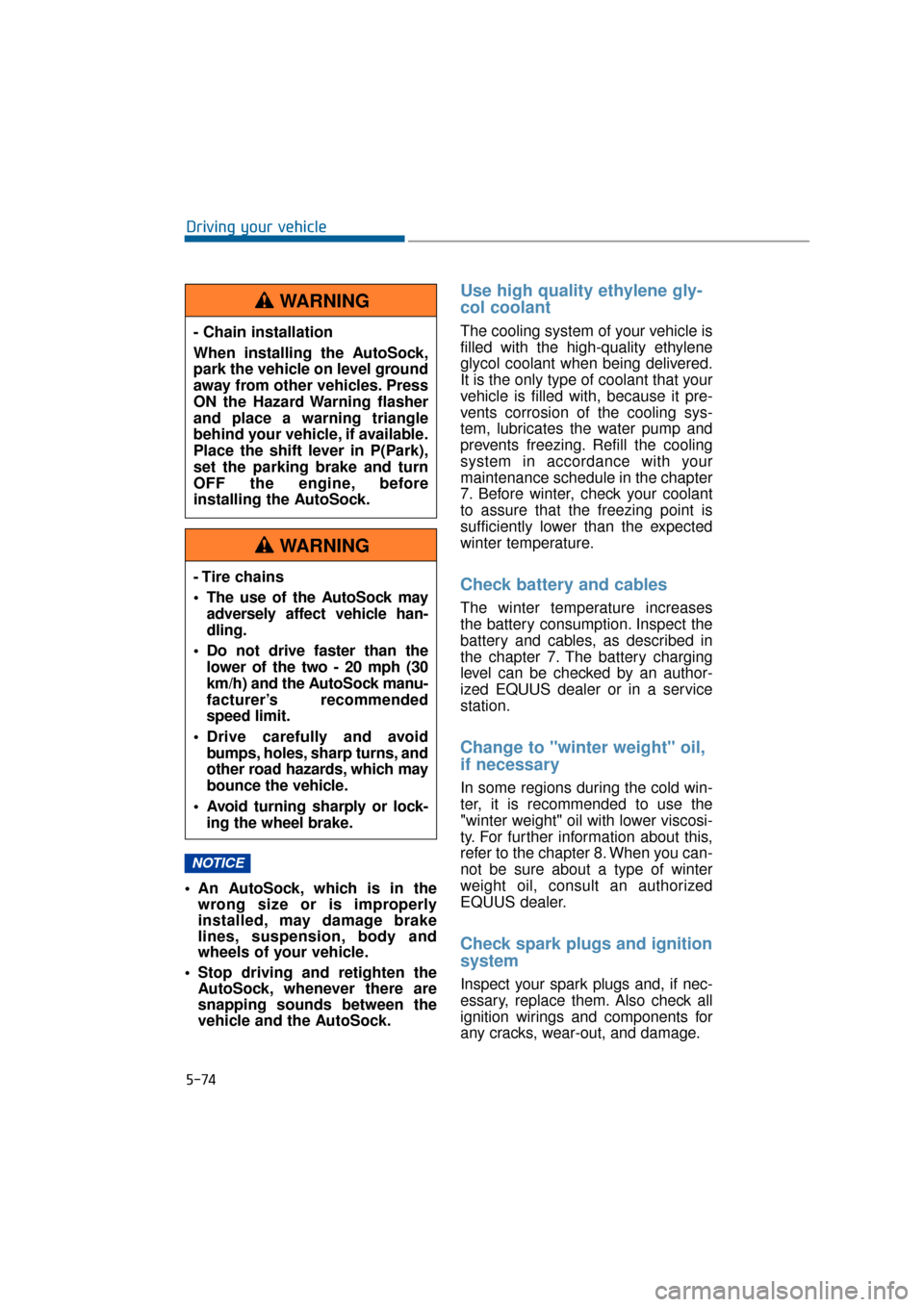
5-74
Driving your vehicle
An AutoSock, which is in the wrong size or is improperly
installed, may damage brake
lines, suspension, body and
wheels of your vehicle.
Stop driving and retighten the AutoSock, whenever there are
snapping sounds between the
vehicle and the AutoSock.
Use high quality ethylene gly-
col coolant
The cooling system of your vehicle is
filled with the high-quality ethylene
glycol coolant when being delivered.
It is the only type of coolant that your
vehicle is filled with, because it pre-
vents corrosion of the cooling sys-
tem, lubricates the water pump and
prevents freezing. Refill the cooling
system in accordance with your
maintenance schedule in the chapter
7. Before winter, check your coolant
to assure that the freezing point is
sufficiently lower than the expected
winter temperature.
Check battery and cables
The winter temperature increases
the battery consumption. Inspect the
battery and cables, as described in
the chapter 7. The battery charging
level can be checked by an author-
ized EQUUS dealer or in a service
station.
Change to "winter weight" oil,
if necessary
In some regions during the cold win-
ter, it is recommended to use the
"winter weight" oil with lower viscosi-
ty. For further information about this,
refer to the chapter 8. When you can-
not be sure about a type of winter
weight oil, consult an authorized
EQUUS dealer.
Check spark plugs and ignition
system
Inspect your spark plugs and, if nec-
essary, replace them. Also check all
ignition wirings and components for
any cracks, wear-out, and damage.
NOTICE
- Chain installation
When installing the AutoSock,
park the vehicle on level ground
away from other vehicles. Press
ON the Hazard Warning flasher
and place a warning triangle
behind your vehicle, if available.
Place the shift lever in P(Park),
set the parking brake and turn
OFF the engine, before
installing the AutoSock.
WARNING
- Tire chains
The use of the AutoSock may
adversely affect vehicle han-
dling.
Do not drive faster than the lower of the two - 20 mph (30
km/h) and the AutoSock manu-
facturer’s recommended
speed limit.
Drive carefully and avoid bumps, holes, sharp turns, and
other road hazards, which may
bounce the vehicle.
Avoid turning sharply or lock- ing the wheel brake.
WARNING
Page 339 of 477
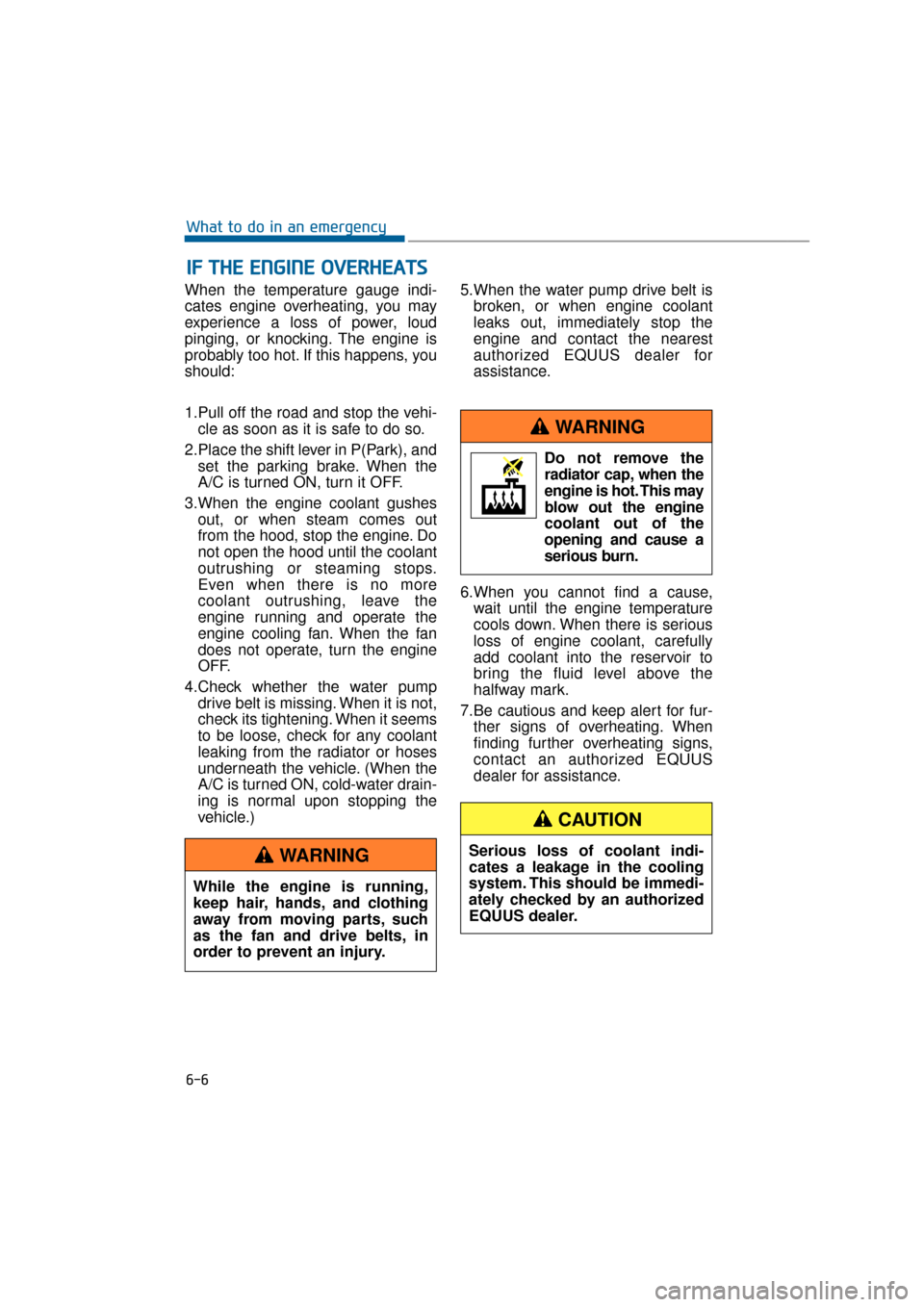
When the temperature gauge indi-
cates engine overheating, you may
experience a loss of power, loud
pinging, or knocking. The engine is
probably too hot. If this happens, you
should:
1.Pull off the road and stop the vehi-cle as soon as it is safe to do so.
2.Place the shift lever in P(Park), and set the parking brake. When the
A/C is turned ON, turn it OFF.
3.When the engine coolant gushes out, or when steam comes out
from the hood, stop the engine. Do
not open the hood until the coolant
outrushing or steaming stops.
Even when there is no more
coolant outrushing, leave the
engine running and operate the
engine cooling fan. When the fan
does not operate, turn the engine
OFF.
4.Check whether the water pump drive belt is missing. When it is not,
check its tightening. When it seems
to be loose, check for any coolant
leaking from the radiator or hoses
underneath the vehicle. (When the
A/C is turned ON, cold-water drain-
ing is normal upon stopping the
vehicle.) 5.When the water pump drive belt is
broken, or when engine coolant
leaks out, immediately stop the
engine and contact the nearest
authorized EQUUS dealer for
assistance.
6.When you cannot find a cause, wait until the engine temperature
cools down. When there is serious
loss of engine coolant, carefully
add coolant into the reservoir to
bring the fluid level above the
halfway mark.
7.Be cautious and keep alert for fur- ther signs of overheating. When
finding further overheating signs,
contact an authorized EQUUS
dealer for assistance.
I IF
F
T
T H
H E
E
E
E N
N G
GI
IN
N E
E
O
O V
VE
ER
R H
H E
EA
A T
TS
S
6-6
What to do in an emergency
While the engine is running,
keep hair, hands, and clothing
away from moving parts, such
as the fan and drive belts, in
order to prevent an injury.
WARNING
Do not remove theradiator cap, when the
engine is hot. This may
blow out the engine
coolant out of the
opening and cause a
serious burn.
WARNING
Serious loss of coolant indi-
cates a leakage in the cooling
system. This should be immedi-
ately checked by an authorized
EQUUS dealer.
CAUTION
Page 384 of 477
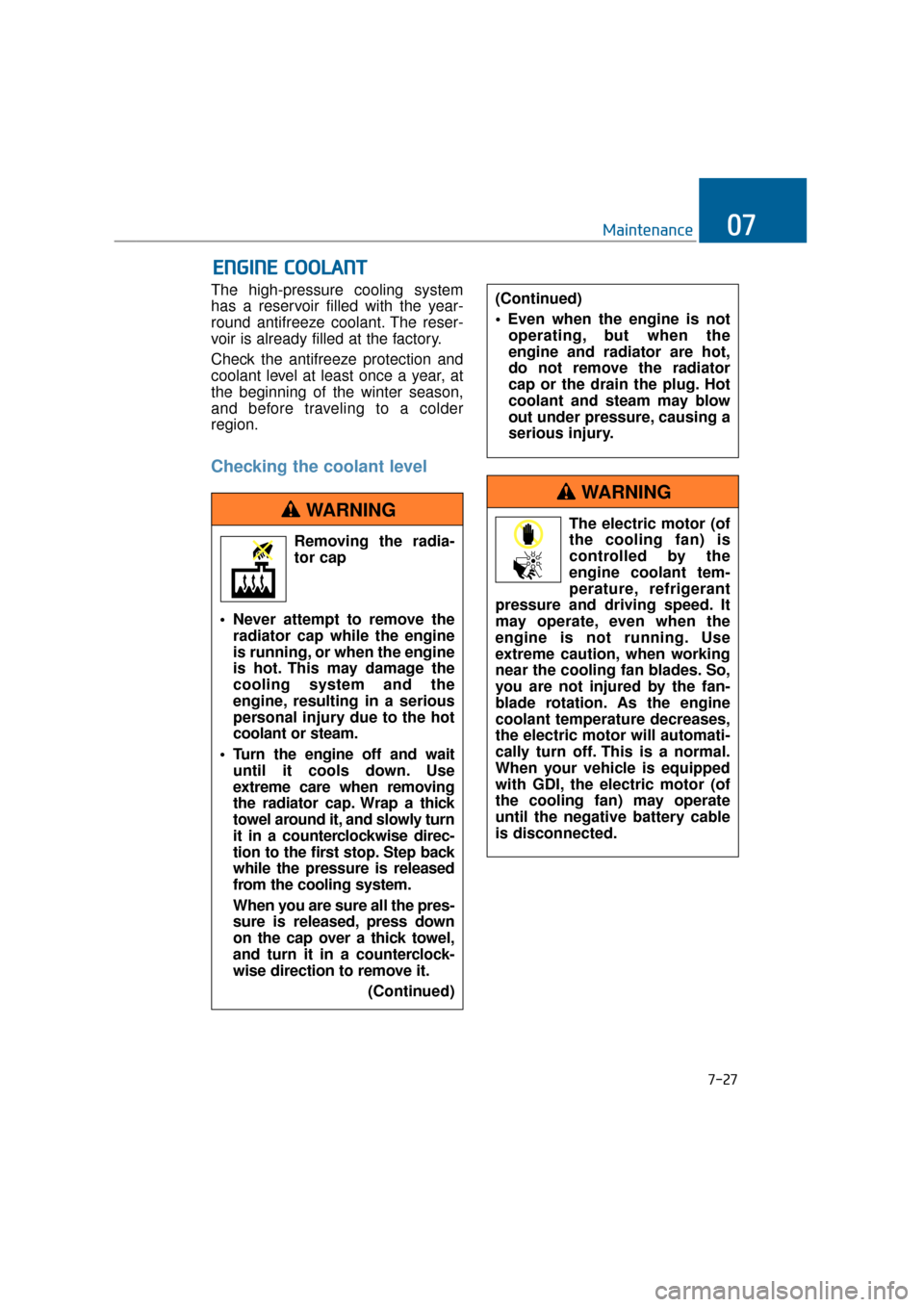
7-27
Maintenance07
The high-pressure cooling system
has a reservoir filled with the year-
round antifreeze coolant. The reser-
voir is already filled at the factory.
Check the antifreeze protection and
coolant level at least once a year, at
the beginning of the winter season,
and before traveling to a colder
region.
Checking the coolant level
E EN
N G
GI
IN
N E
E
C
C O
O O
OL
LA
A N
N T
T
(Continued)
operating, but when the
engine and radiator are hot,
do not remove the radiator
cap or the drain the plug. Hot
coolant and steam may blow
out under pressure, causing a
serious injury.
The electric motor (of
the cooling fan) is
controlled by the
engine coolant tem-
perature, refrigerant
pressure and driving speed. It
may operate, even when the
engine is not running. Use
extreme caution, when working
near the cooling fan blades. So,
you are not injured by the fan-
blade rotation. As the engine
coolant temperature decreases,
the electric motor will automati-
cally turn off. This is a normal.
When your vehicle is equipped
with GDI, the electric motor (of
the cooling fan) may operate
until the negative battery cable
is disconnected.
WARNING
Removing the radia-
tor cap
Never attempt to remove the radiator cap while the engine
is running, or when the engine
is hot. This may damage the
cooling system and the
engine, resulting in a serious
personal injury due to the hot
coolant or steam.
Turn the engine off and wait until it cools down. Use
extreme care when removing
the radiator cap. Wrap a thick
towel around it, and slowly turn
it in a counterclockwise direc-
tion to the first stop. Step back
while the pressure is released
from the cooling system.
When you are sure all the pres-
sure is released, press down
on the cap over a thick towel,
and turn it in a counterclock-
wise direction to remove it.
(Continued)
WARNING
Page 385 of 477
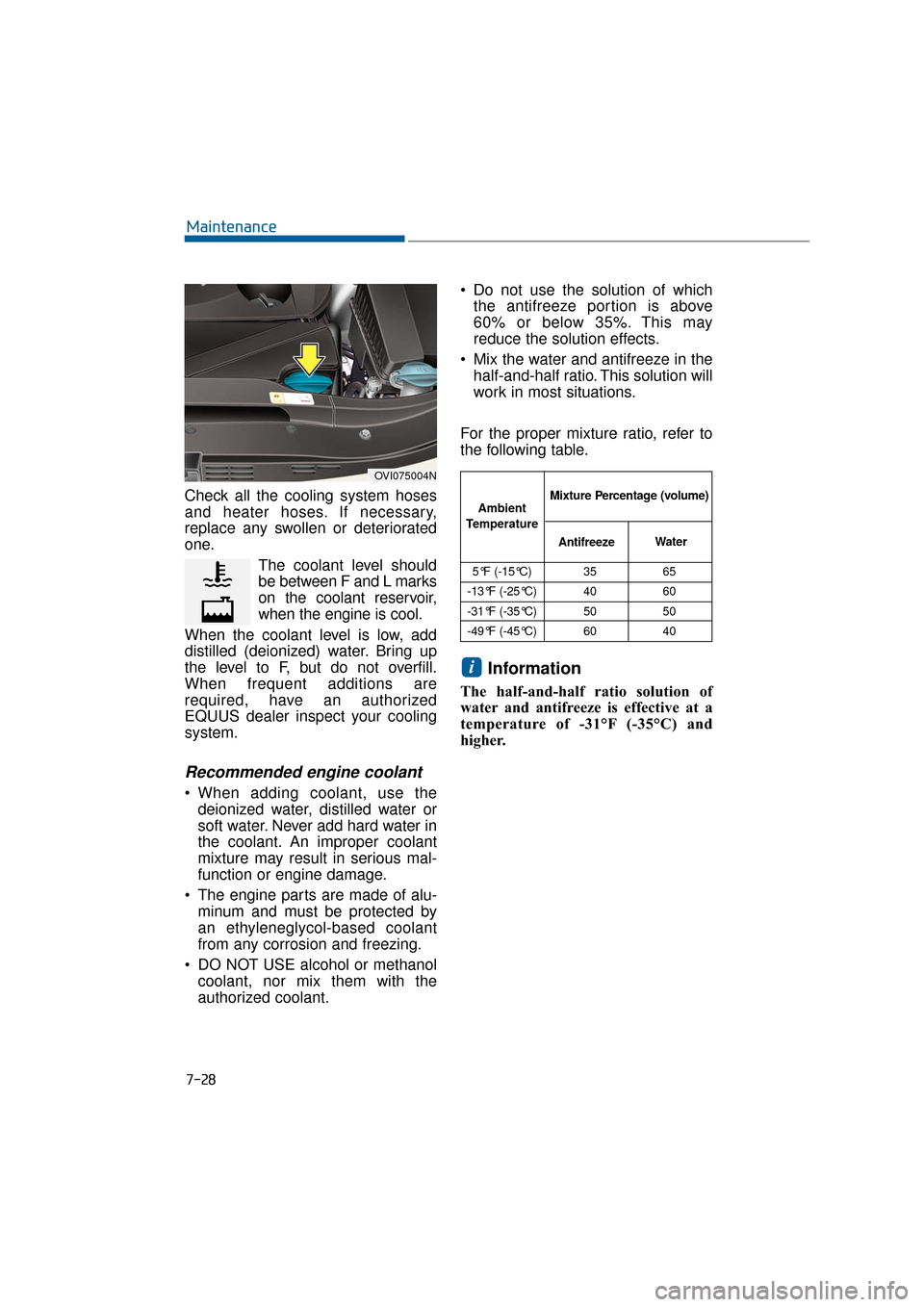
7-28
Maintenance
Check all the cooling system hoses
and heater hoses. If necessary,
replace any swollen or deteriorated
one. The coolant level should
be between F and L marks
on the coolant reservoir,
when the engine is cool.
When the coolant level is low, add
distilled (deionized) water. Bring up
the level to F, but do not overfill.
When frequent additions are
required, have an authorized
EQUUS dealer inspect your cooling
system.
Recommended engine coolant
When adding coolant, use the deionized water, distilled water or
soft water. Never add hard water in
the coolant. An improper coolant
mixture may result in serious mal-
function or engine damage.
The engine parts are made of alu- minum and must be protected by
an ethyleneglycol-based coolant
from any corrosion and freezing.
DO NOT USE alcohol or methanol coolant, nor mix them with the
authorized coolant. Do not use the solution of which
the antifreeze portion is above
60% or below 35%. This may
reduce the solution effects.
Mix the water and antifreeze in the half-and-half ratio. This solution will
work in most situations.
For the proper mixture ratio, refer to
the following table.
Information
The half-and-half ratio solution of
water and antifreeze is effective at a
temperature of -31°F (-35°C) and
higher.
i
OVI075004N
5°F (-15°C) 35 65
-13°F (-25°C) 40 60
-31°F (-35°C) 50 50
-49°F (-45°C) 60 40
Ambient
Temperature Mixture Percentage (volume)
Antifreeze Water
Page 389 of 477
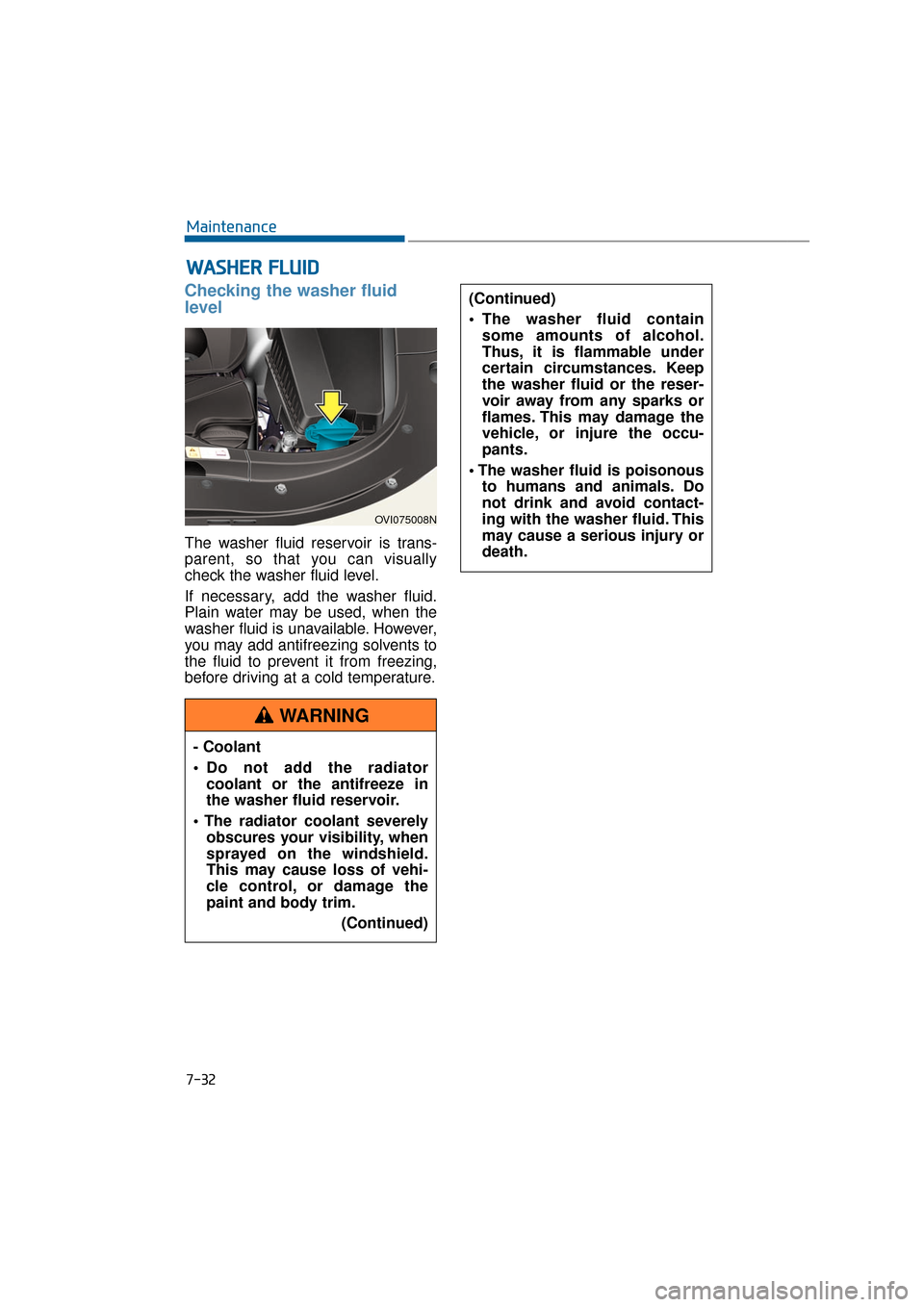
7-32
Maintenance
Checking the washer fluid
level
The washer fluid reservoir is trans-
parent, so that you can visually
check the washer fluid level.
If necessary, add the washer fluid.
Plain water may be used, when the
washer fluid is unavailable. However,
you may add antifreezing solvents to
the fluid to prevent it from freezing,
before driving at a cold temperature.
W WA
AS
SH
H E
ER
R
F
F L
LU
U I
ID
D
OVI075008N
- Coolant
Do not add the radiator
coolant or the antifreeze in
the washer fluid reservoir.
obscures your visibility, when
sprayed on the windshield.
This may cause loss of vehi-
cle control, or damage the
paint and body trim.
(Continued)
(Continued)
The washer fluid containsome amounts of alcohol.
Thus, it is flammable under
certain circumstances. Keep
the washer fluid or the reser-
voir away from any sparks or
flames. This may damage the
vehicle, or injure the occu-
pants.
to humans and animals. Do
not drink and avoid contact-
ing with the washer fluid. This
may cause a serious injury or
death.
WARNING
Page 447 of 477
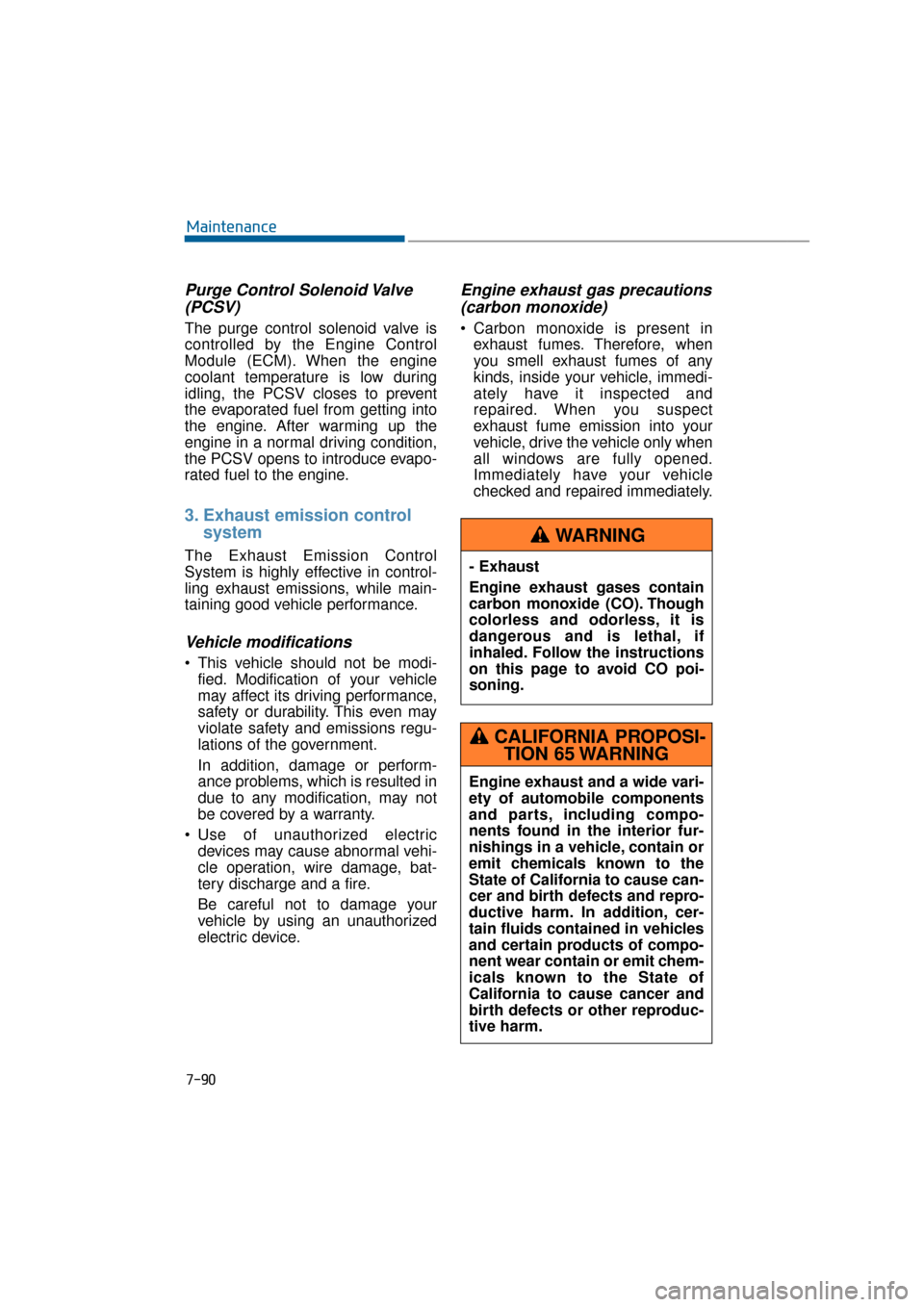
7-90
Maintenance
Purge Control Solenoid Valve(PCSV)
The purge control solenoid valve is
controlled by the Engine Control
Module (ECM). When the engine
coolant temperature is low during
idling, the PCSV closes to prevent
the evaporated fuel from getting into
the engine. After warming up the
engine in a normal driving condition,
the PCSV opens to introduce evapo-
rated fuel to the engine.
3. Exhaust emission control system
The Exhaust Emission Control
System is highly effective in control-
ling exhaust emissions, while main-
taining good vehicle performance.
Vehicle modifications
This vehicle should not be modi-
fied. Modification of your vehicle
may affect its driving performance,
safety or durability. This even may
violate safety and emissions regu-
lations of the government.
In addition, damage or perform-
ance problems, which is resulted in
due to any modification, may not
be covered by a warranty.
Use of unauthorized electric devices may cause abnormal vehi-
cle operation, wire damage, bat-
tery discharge and a fire.
Be careful not to damage your
vehicle by using an unauthorized
electric device.
Engine exhaust gas precautions (carbon monoxide)
Carbon monoxide is present in
exhaust fumes. Therefore, when
you smell exhaust fumes of any
kinds, inside your vehicle, immedi-
ately have it inspected and
repaired. When you suspect
exhaust fume emission into your
vehicle, drive the vehicle only when
all windows are fully opened.
Immediately have your vehicle
checked and repaired immediately.
- Exhaust
Engine exhaust gases contain
carbon monoxide (CO). Though
colorless and odorless, it is
dangerous and is lethal, if
inhaled. Follow the instructions
on this page to avoid CO poi-
soning.
WARNING
Engine exhaust and a wide vari-
ety of automobile components
and parts, including compo-
nents found in the interior fur-
nishings in a vehicle, contain or
emit chemicals known to the
State of California to cause can-
cer and birth defects and repro-
ductive harm. In addition, cer-
tain fluids contained in vehicles
and certain products of compo-
nent wear contain or emit chem-
icals known to the State of
California to cause cancer and
birth defects or other reproduc-
tive harm.
CALIFORNIA PROPOSI- TION 65 WARNING